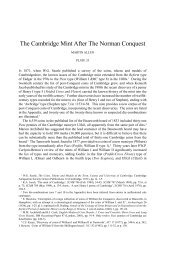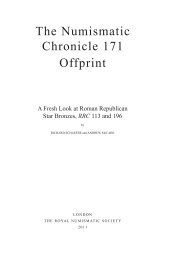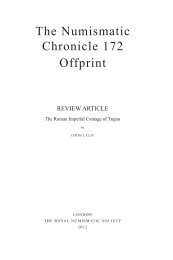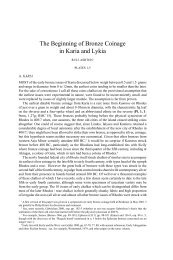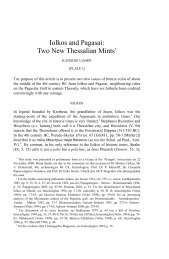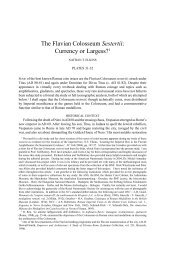The Numismatic Chronicle 171 Offprint - Royal Numismatic Society
The Numismatic Chronicle 171 Offprint - Royal Numismatic Society
The Numismatic Chronicle 171 Offprint - Royal Numismatic Society
You also want an ePaper? Increase the reach of your titles
YUMPU automatically turns print PDFs into web optimized ePapers that Google loves.
370<br />
FRANÇOIS THIERRY<br />
A detailed study of the moral maxims in the light of the practice of taboo characters<br />
(Ch. hui; Viet. húy 諱) explains the removal of particular types during particular<br />
reigns. For example, four types of inscriptions found on coins of the Minh Mạng<br />
era contained taboo characters and were thus discontinued. It was an old tradition<br />
in the sinicised world not to use a character which was present in the personal or<br />
offi cial name of the emperor, the empress or an imperial ancestor. A taboo character<br />
would be replaced with a homonym or a non-orthodox version of that character. 16<br />
Particular respect was paid to the custom of taboo characters during the Nguyễn<br />
dynasty. In an ordinance of the third moon of the second year of Gia Long (1803),<br />
the emperor ordered the Ministry of Rites to distribute information about taboo<br />
characters throughout the empire; all personal or place names which were similar to<br />
a taboo character were to be modifi ed, and replacement characters appropriate to the<br />
context were to be used. 17<br />
Type 28 was discontinued in the Thiệu Trị era because the character Hoa 華 was<br />
declared a taboo character in the ordinance of the second moon of the fi rst year of<br />
Thiệu Trị, on the grounds that it appeared in the personal name of the emperor’s<br />
mother, Hồ Thị Hoa 胡氏華 (1790–1806). 18 Reminders that this was a taboo character<br />
were made several times during the Thiệu Trị era and in the ordinance of the 14th<br />
year of the Tự Đức era. 19<br />
Types 27 and 36 were also absent from the 1871 issue, because the character an<br />
安 had been declared taboo in 1861 (the 14th year of the Tự Đức era). In that year,<br />
the emperor noticed in a petition the name of a certain Lê Tiền Hoàng written with<br />
the character Hoàng 潢, which showed that the taboo on characters in the personal<br />
names of imperial ancestors was not being strictly applied, the imperial ancestor’s<br />
name in this case being Nguyễn Hoàng 潢. It was thus ordered that a list should<br />
be drawn up of all the characters that were taboo, or that should be taboo, with the<br />
intention of making them known in a special ordinance. In this way, 47 characters<br />
were declared taboo, of which 17 were new, including the character An 安, which<br />
was the family name of the mother of Nguyễn Phúc Tần (1648–87). 20<br />
Type 47 was dropped for similar reasons during the Tự Đức era, as it contained the<br />
character thì 時. At his accession to the throne at the end of the Thiệu Trị era, Prince<br />
Nguyễn Hồng Nậm was given the offi cial name Thì, and this character immediately<br />
became taboo in an ordinance of the tenth moon of the seventh year of the Thiệu Trị<br />
era. <strong>The</strong> ordinance specifi ed that ‘thì in terms such as Thì khắc, is to be replaced with<br />
16 We know that the character bang 邦, which means ‘country’ or ‘state’, and which is the personal<br />
name of the founder of the Han dynasty, Liu Bang (ruled 206–195 BC), was replaced in contemporary<br />
Chinese texts by guo 國 which has a similar meaning. <strong>The</strong> characters shi 世 and min 民, which were<br />
part of the personal name of Li Shimin, Emperor Taizong of the Tang dynasty (627–49) and which were<br />
frequently used, were also modifi ed so that they could be written without contravening the ritual, see Li<br />
ZG, p. 5, and Soymié, ‘Observations sur les caractères interdits’, pp. 388–90.<br />
17 Đại Nam thực lục, Chính biên, quoted by Ngô DT, p. 325.<br />
18 <strong>The</strong> daughter of a military man, she was selected as the fi rst wife of the second grade by Đảm<br />
(future emperor Thánh Tổ, Minh Mạng era), but died at the age of seventeen, thirteen days after giving<br />
birth to the future emperor Hiến Tổ, of the Thiệu Trị era.<br />
19 Ngô DT, pp. 348, 350, 357, 365–6.<br />
20 Ngô DT, pp. 365–6.



